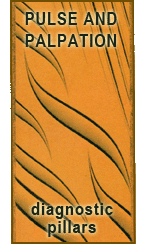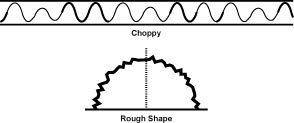The Choppy, Hesitant, Rough, or Sluggish Pulse (Se Mai)

Choppy Pulse (?? Se Mai, hesitant, rough, sluggish)
Key points: un-smooth, short, mutable, changes rapidly in both rate and strength
Indications: (forceful) stagnation of qi, blood, food, or phlegm: pathogens block the vessels and impair the blood circulation.
(Forceless) Deficiency of blood or jing: deficiencies can’t fill the vessels, leading to uneven flow.
(Inconsistent rate) the 3/5 pulse is another expression of “choppy”.
Alism: the slightly choppy pulse (not necessarily the opposite of slippery). See “staircase” image below.
Explanation: the choppy pulse is one of those pulses that are difficult to communicate through words, as such it is very helpful to actually feel a few choppy pulses to recognize them in the clinical setting. I have run into a few low-grade choppy pulses which I describe as a staircase sensation on the downside of the pulse wave. Here’s an image describing it:

The Low-grade Choppy Pulse
Again, we’ll divide the choppy pulse into the forceful kind and the forceless type.
The forceful choppy pulse gets that way thanks to excessive pathogenic factors blocking the vessels and thus impairing the circulation of the blood.
The forceless kind of choppy pulse arises from a lack of blood or jing (essence) which results in a weak and uneven pulse wave or force.
As usual, Chinese medicine diagnosis is not based on one finding or observation, but a triangulation or synthesis of many signs and symptoms. In the case of the tongue body color, blood stagnation due to excess factors will likely present with a deeply colored purple tongue while the deficiency type blood stagnation may manifest with a pale purple tongue. Bob Flaws, on his pulse seminar CD describes another kind of “choppy buy hydrocodone 10 325 online pulse” as the “3-5 pulse”. This particular pulse is not described in the source text from which much of this article comes. However I have felt this pulse and would like to describe it in further detail as I believe it is something that we can all be aware of.
The “3-5 pulse” could be described as a pulse that is irregular in terms of pulse rate. It is slow, then fast. There are no missed beats, so this isn’t an irregular (or arrhythmic) pulse, rather it is slow (3 beats per breath) and then fast (5 beats per breath). Hence the name the “3-5 pulse”.
Alism: I have also noticed that those with the slow/fast pulse can be hypersensitive emotionally. It is particularly evident when asking about aspects of their life while checking their pulse. When you ask about something with no emotional charge, the pulse remains stable and relaxed. However, when asking about something that does have an emotional charge, the pulse can get quicker and stronger for a few beats until it settles down again. This may not automatically suggest a choppy pulse, or qi or blood stagnation. However this response of the Heart can be correlated to an internal cause of blood stagnation, namely emotional hypersensitivity and/or “stress”.
Do note also that it is normal for the pulse to be slightly faster during an inhalation than during an exhalation. This is normal physiology. It is subtle and may not be evident unless you are in a very calm and focused state of mind. Not all patients will exhibit this, either.

The Choppy Pulse
Next: don’t stress, its only the wiry pulse.
 Last modified: July 19, 2009
Last modified: July 19, 2009  Tags: Diagnosis, Palpation В· Posted in: Pulse Class, Pulse-Palpation
Tags: Diagnosis, Palpation В· Posted in: Pulse Class, Pulse-Palpation
